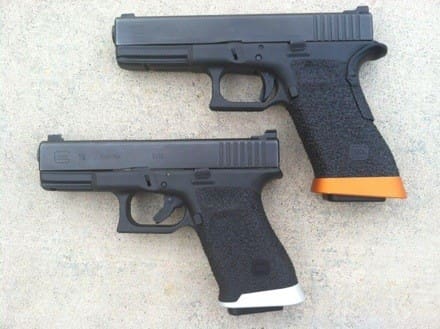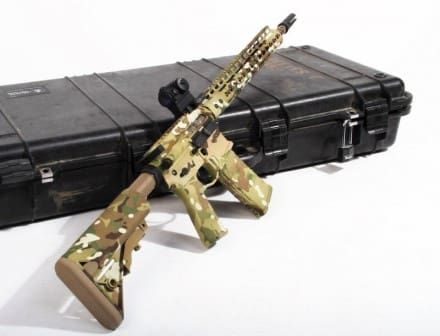This is the Torture Test II DDM4 from the recent TAC-TV episode.
This new Dragon Lock holster retention system from DownEast offers Level 3 retention on a fabric holster. The design is ambidextrous and can be changed with simple tools. It will also work on Kydex or polymer holsters but was really designed for use with fabric holsters.
This is huge for small manufacturers and will be tooled up and ready to go in a month.
Additionally, DownEast has been working to improve how their polymer feed chute actually attaches to the weapon. They’ve developed a new two piece feed chute collar.
Each year Crye Precision sponsors a silent auction with proceeds going to military charities. In years past you had to be present at the party to participate but this year they have opened it up TPT all attendees. In addition to the Boba Fett themed AirFrame helmet and Salient Arms MultiCam Glock, the are a couple of other items you need to check out in booth #27403.
A custom Salient Arms Mossberg 930
A custom Salient Arms Mossberg M590A1
Yesterday, we were shown a prototype mag well for the GLOCK 19 and 23 by Sentinel Design and www.austereprovisions.com.

photo – Austere Provisions Company
These use installed mag wells are compatible with factory GLOCK +2 baseplates and copies, Arredondo +2 and +5 extensions, Magpul Speedplates, as well as Dawson Precision’s excellent extended tool-less magazine extensions and Ez-Off baseplates.
They’re almost there and hopefully we’ll see these late Spring.
Princeton Tec has introduced a new light called the Switch Rail. It is a Picatinny compatible, waterproof to 1m low output light for structure search, navigation, low level illumination and breaching operations. This light is a collaboration between Austere Provisions Company, Sentinel Designs LLC and Princeton Tec.
The Switch Rail offers 10 lumens for up to 36 hours using 2 each 2016 coin batteries. Available lamp options include IR/Red and IR/White.
See the TALON gyro-stabilized gun platform from Paradigm at the Legion Firearms booth (# 27108). This thing has come a long way since its first appearance on Soldier Systems. First off, they’ve added a camera system – one sensor looks through the scope and one offers a wide angle view of the target area. They also added a range finder and the system automatically calculates shot distance from heights and displays it on the hand controller screen. The TALON is totally automated and stabilized for helicopters, boats, and vehicles.
The photo shows a SCAR H mounted in the TALON, but any weapon with a bottom rail on the hand guard can be utilized.
Legion Firearms is launching several new firearms during SHOT Show. Descriptions are from Legion.
We call our LF-10d “The Heavy.” It offers all of the amenities of its smaller-bore cousins like NiB components, Cerakote topcoating, and a HEX fluted barrel. Its billet construction, advanced barrel, and light weight make it a perfect battle rifle or DMR. The LF-10d rifle uses .308 Winchester (7.62 x 51mm) ammunition. Also available independently:
• built LF-10d billet upper receiver
• built LF-10 billet lower receiver
• stripped LF-10d billet upper receiver
• stripped LF-10 billet lower receiver
• billet construction 7075-T6 aluminum upper and lower
• Nickle-Boron coated upper, lower, and bolt carrier group
• 14.5” / 16” HEX fluted 416 stainless steel barrel
• SureFire muzzle break (pinned & welded on 14. 5” barrels)
• ambidextrous Legion Raptor charging handle
• ambidextrous safety selector
• Geissele SSA trigger
• REVO Sling Attachment System
• MagPul MOE grip and B5 SOPMOD
Noted firearms tactician and Orion Design Group founder Brian Bishop has become a valuable asset to the Legion Firearms team. His innovative approach to weapon systems and concealment technology are brought to bear in every product he designs. Legion is proud to partner with ODG to present this “tricked out” yet “no nonsense” combat rifle featuring the Lupus Camouflage pattern. The LF-4d Orion Design Group Edition rifle uses 5.56 x 45mm NATO (.223 Remington) ammunition.
• forged 7075-T6 aluminum upper and lower
• Nickle-Boron coated upper, lower, and bolt carrier group
• Geissele MK1 Super Mod hand guard
• 14.5” HEX fluted 416 stainless steel barrel
• adjustable gas block
• SureFire muzzle break
• ambidextrous Legion Raptor charging handle
• ambidextrous safety selector
• Geissele SSA trigger
• MagPul MOE grip and CTR stock
• ODG Tactical Sling
• ODG Lupus Camo ink transfer
LEGION LF-15d PARADIGM EDITION

Paradigm SRP is a global security and defense provider who has set the gold standard in protective services and asset recovery. Their innovative mindset and ambitious mantra, “targeting today’s challenges with tomorrow’s technologies,” made them a perfect partner for developing this combat rifle. The LF-15d Paradigm Edition rifle uses 5.56 x 45mm NATO (.223 Remington) ammunition. Available exclusively through Paradigm SRP.
• billet construction 7075-T6 aluminum upper and lower
• Nickle-Boron coated upper, lower, and bolt carrier group
• Noveske NSR hand guard
• 16” HEX fluted 416 stainless steel barrel
• adjustable gas block
• SureFire flash hider
• ambidextrous Legion Raptor charging handle
• ambidextrous mag release, safety selector, and bolt release
• CMC Triggers 3.5 lb. curved trigger
• BCM Gunfighter Mod 1 grip and B5 SOPMOD stock
• MultiCam ink transfer